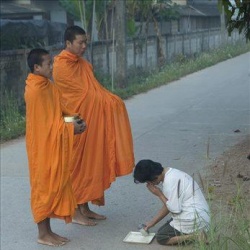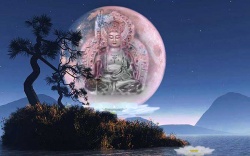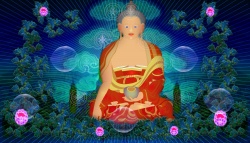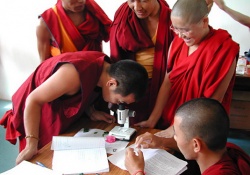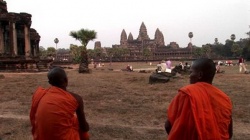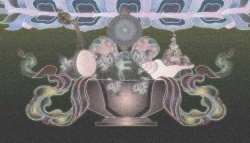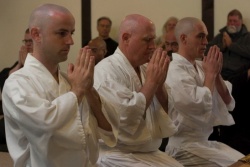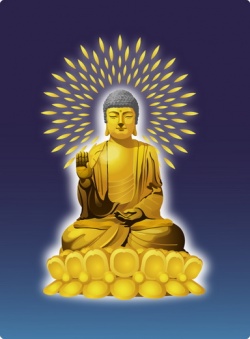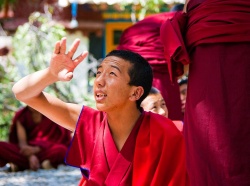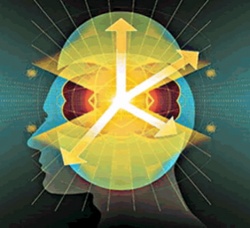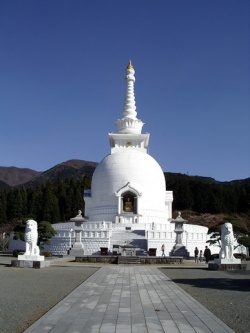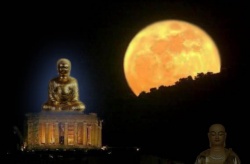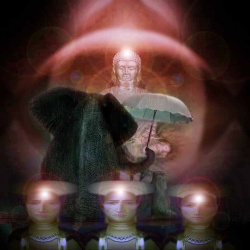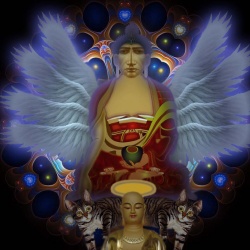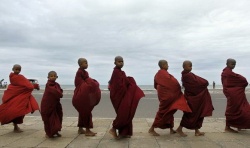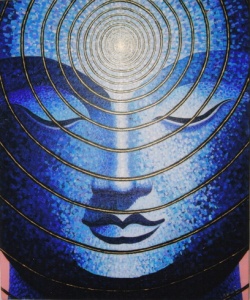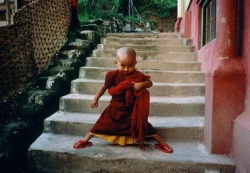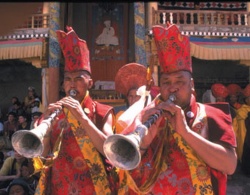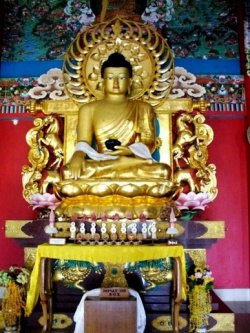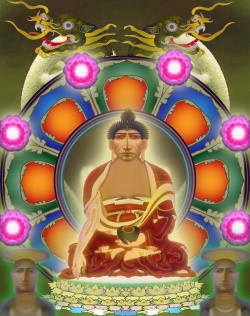Buddhist Ethics and End-of-Life Care Decisions
Buddhism has grown in the United States in the past 50 years. Immigrants come following long traditions. American converts are more eclectic. The first Buddhist precept prohibiting harm to living things, the virtue of compassion, and the goal of a peaceful death provide guidance for ethical decision making regarding organ donation, withholding and withdrawing life-sustaining treatment, voluntary cessation of eating, physician aid in dying, and euthanasia. Concepts and views from three Buddhist traditions and views of master practitioners are presented. Case examples illustrate some of the differences within Buddhism. Suggestions for social workers are provided.
INTRODUCTION
Buddhism has been growing in the United States for the past 50 years. Changes in immigration laws and participation of Americans in Buddhism have contributed to a continuing sharp rise in the number of Buddhists in America. During the period from 1964 to 1975, the number of Buddhist centers in the United States increased fivefold. The number then doubled by 1984 and doubled again by 1997 with over 1,000 centers operating in the country (Prebish, 1999). There are now an estimated 3–4 million Buddhists in the United States with about 800,000 of them Euro-American converts to the religion (Prebish, 1999). Buddhism developed in Asian countries that had not experienced the Age of Enlightenment of 18th century Europe and the rise of science. As it has moved to the West, practitioners of the religion are confronted with medical ethical questions that had not arisen for Buddhist teachers. Recently Buddhist scholars have addressed these questions and with regard to end-of-life care questions, one has put it bluntly that, “Buddhism is a third-world phenomenon and several hundred years out of date” (Keown, 2001, p. 7).
Many Westerners have found the spiritual perspectives of Buddhism refreshing and have been seeking a way to apply the teachings they have learned to life's problems including medical ethics questions (Keown, 2001). This review focuses on ethics in end-of-life care decisions. I first summarize Buddhist beliefs and ethics and then distill the exegesis of Buddhist scholars who have reviewed primary texts into an overview. In the process I will use a few terms in Sanskrit for which there are poor English equivalents but many of them are recognizable by English speakers.
ORIGIN, SPREAD, AND SCHOOLS OF BUDDHISM
Buddhism began about 2,500 years ago in India when Siddhartha Gautama, the protected son of wealthy parents, left his home to confront the reality of life. His charioteer explained that old age, sickness, and death come to all people. He also met a mendicant who explained that suffering was a reality in the world but that Gautama could learn to overcome it. Gautama's renunciation of domestic life and his “Going Forth” into homelessness was followed by many years of training before he was able to achieve the meditative state of perfect enlightenment (samadhi; Armstrong, 2001). Once successful, he began a life of teaching which spanned the next 45 years until his death in about 400 BCE.
What remains of the teachings of the Buddha are compiled in the Theravada Pali Canon, which is respected by the three main branches of Buddhism as the primary source of the Buddha's teaching. It had been committed to memory by generations of monks and was the earliest of all the texts to be transcribed when it was put into writing in Sri Lanka in about 40 BCE (Harvey, 1990). The canon is comprised of a number of documents including the Vinaya Pitaka, the Monastic Rule set down by the Buddha, and Buddhaghosa's (1970) Commentary on the Vinaya written in 5 CE (Harvey, 2011; Keown, 2001).
Southern Buddhism follows these Theravada texts most closely and is practiced in Sri Lanka, Myanmar (Burma), Thailand, Laos, and Cambodia. Eastern Buddhism is stronger in the Mahayana tradition which emphasizes compassion (karuna) as described in the writing of Santedeva and in the Lotus Sutra (Harvey, 2011). It is more prevalent in China, Taiwan, Vietnam, and Japan and has produced offshoots such as Zen, Pure Land, and Nicheren Buddhism. Northern Buddhism is primarily Tibetan Buddhism, also called Vajrayana, which grew out of the Mahayana tradition in Northern India and is still practiced there and in Tibet, Nepal, and Mongolia (Harvey, 1990).
Zen Buddhism first reached the United States in 1893. It grew in the counterculture era of the 1950s “Beat” generation and continued its growth during the 1960s and 1970s as Zen centers based on practice in several East Asian traditions were founded. Tibetan Buddhism is well represented in the United States. The largest group is Shambhala International founded by Chogyam Trungpa Rinpoche. It is a more secular form of meditation practice emphasizing psychological and personal growth. The Theravada school from Southeast Asia is also represented and it includes an adaptation called Insight Meditation developed by Mahasi Sayadaw. It focuses on the vipassana meditation technique and has become quite popular among American practitioners. A form of Vietnamese Buddhism called Interbeing was developed by Thich Nhat Hanh and is considered the beginning of the practice of “engaged” Buddhism which emphasizes involvement in the political and social arenas.
Buddhism is a fluid religion. Almost all of the above-mentioned Buddhist traditions are practiced in the United States creating a unique situation in the world. In other countries one practice tradition dominates and young people grow up practicing Buddhism as their family has with little exposure to other forms of practice. In the United States the presence of many traditions of Buddhism provides a range of choices and sometimes hybrid practices among American converts to the religion.
Asian immigrants tend to remain in the tradition they learned in their country of origin. Some of these practitioners of Buddhism may also participate in older indigenous traditions and carry on local customs such as following the nature gods of Sri Lanka, Confucianism in China, and Shinto in Japan (Harvey, 1990). This sharing of religious expression also occurs in the West (Boorstein, 1997). It is also in keeping with Buddha's approach. Since he was most concerned with the practice that led to enlightenment, he was not concerned about people's involvement with other religions (Armstrong, 2001). Americans who experiment with Buddhism or convert to the religion tend to seek a variety of teachers and experiences and are less loyal to one tradition. This variety in practice poses potential problems for social workers and other health care practitioners in their approach to Buddhists in discussing end-of-life care issues for not only do they have to know something about Buddhism but they must also be aware of some of the differences within Buddhism.
BASIC BUDDHIST TEACHINGS AND END-OF-LIFE CARE DECISIONS
The essence of Buddhism is that the Buddha's experience of enlightenment is available to anyone who is willing to pursue the training and practice. He taught that all beings experience the continual cycle of rebirths (samsara) and the suffering (dukkha) that ensues. The form of rebirth a person experiences is influenced by karma, the natural consequence of their actions. The state of a person's mind at the time of death and the karmic merit they have earned will determine the type of rebirth they will experience. After the Buddha reached the state of awakeness (nirvana), he began to share his teachings (dharma) on how to reach nirvana and attain freedom from samsara. As he traveled, he formed a community of followers (sangha) in each of the areas where he taught. The sangha was originally a community of monks and nuns which evolved to include lay people to provide support for all practitioners.
Buddha's preaching emphasized awareness of and preparation for death as a guiding principle for actions that will promote positive karma. However, most people are quite frightened of death (Yalom, 2011), and a focus on death is very challenging to the average person. “Humans beings are the only animals who have to live with the knowledge that they will one day die, and have always found this vision of extinction difficult to contemplate” (Armstrong, 2001, p. 4). Buddhists have learned that this awareness of death provides two ways to motivate practitioners. “(Death) is a source of useful disgust and useful fear. The disgust is an antidote to lust; the fear is an antidote to laziness” (Dhammavidu as cited in Stonington, 2011, p. 118). The Buddhist practice of meditating on death and the decay of the body is designed to lead the practitioner to an experience of disgust with the body and its desire for attachment to things and people. Once reaching the realization of the futility of seeking these attachments, the practitioner can more easily forsake them and face death with no attachment for life. From a different perspective fear of multiple deaths following rebirths can spur practitioners to seek the enlightened state, which will free them from the cycle of rebirths. Once freed from fear in this way, a practitioner will be in a position to welcome death as a final release from samsara.
Such a view does not contradict the belief that a rebirth as a human being is extremely fortunate for it is only as a human being that one may attain enlightenment. Even if a person is not fully enlightened, an acceptable goal of life is to be reborn as a more enlightened person with greater ability to attain nirvana. Decisions about events in life including those at the end of life will have an impact on the merit attained at death. Making ethical choices will be important in this process. A difficulty for Buddhists today is that there is not a systematic presentation of ethical principles upon which they can base their decisions about medical matters since they could not have been foreseen when Buddhism developed (Keown, 2001).
Ethical guidance is provided in part by Buddhist scriptures which list five precepts which apply to all, other precepts which can be accepted voluntarily on holidays or during periods of study or retreat, and still others which apply to monks. The first precept is respect for life or non-harming (ahimsa). It prohibits the killing of living things and is the most important precept regarding end-of-life care. Keown (1998) prefers to consider it the “inviolability of life” giving the virtue a stronger focus. Life is a basic good in Buddhism and its preservation is important, for it is only when in human form that one can freely choose morally good actions to improve chances for a higher rebirth thus bringing one closer to nirvana and the end of suffering.
Buddhists give credence to four authorities in testing an opinion on an issue. The four are: (a) what is written in scripture, (b) what would be in conformity with scripture, (c) the tradition of commentary, and (d) a personal opinion based on study of the other three (Keown, 2001). The Theravada tradition upon which Keown (2001, 2005a) bases his discussion follows the traditional texts and the first two authorities most closely. The Mahayana tradition is based more on commentary, in particular that by Santideva, and will allow for motivation based on compassion and more latitude for personal opinion (Goodman, 2009). In all cases, when a practitioner relies on personal opinion, a clear mind free of prejudice is required so that the decision is based on skillful means (upaya). The act must be undertaken with the purest intentions of helping another. This role of personal opinion is important to keep in mind if someone is contemplating a decision that would violate strict interpretation of a precept. Social workers can help that person sort through their concerns about such a violation which may include the karmic consequences to both the patient and a family member who is making a decision that has the potential for relieving suffering and promoting a peaceful death, but may hasten death. For example, the decision to use intravenous morphine at the end of life will require good information and a clear mind to help a person maintain congruency with their religious beliefs, ethical standards, and the wishes of the patient. Other end-of-life care decisions will be discussed in the sections that follow.
These ethical principles function to guide a Buddhist toward the important goal of establishing a moral character built by behaving ethically. The quality of character results from karma earned by previous behavior.
The (Buddhist) perspective views morality as part of a spiritual path which largely consists of cultivating a more wholesome character by undermining moral/spiritual defilements and cultivating counteractive virtues. … This entails that what one does, and how and why one does it, is of great import: for one's actions both express and shape one's character, and contribute to one's destiny. (Harvey, 2011, p. 58)
However, it is not the karmic merit which determines the goodness of an action. From the Buddhist point of view, actions can be good or bad in and of themselves, and “an act is seen to have unpleasant karmic results because it is wrong; it is not seen as ‘wrong’ because it happens to produce bad karmic results” (Harvey, 2011, p. 59).
Further development of character will deepen awareness regarding the intention of an action, which for Buddhists is almost as important as the action itself. Latitude is given and less bad karma is accumulated if a person's intentions for an action are good. For example, in the Mahayana tradition a person who acts from compassion will be held less culpable if the action turns out badly.
Because of differences in traditions and local customs, Buddhists will differ in how much they emphasize the karma earned from specific decisions made at the end of life. Such decisions regarding organ donation, withholding or withdrawing life-sustaining treatment such as artificial nutrition and hydration and mechanical ventilation, physician-aid in dying (assisted suicide) and euthanasia all hold the potential for creating good or bad karma. Buddhists from the Theravada tradition will be more likely to follow the precepts literally, while those from the Mahayana and Tibetan traditions will emphasize compassion and be more lenient if a decision counteracts a principle.
DETERMINATION OF DEATH AND ORGAN DONATION
Organ donation has become very common in many hospitals around the world and these hospitals are active in their search for additional donors. Some countries have passed laws that allow a hospital to assume that a person will donate their organs and they can proceed with this process unless the patient or their surrogate decides against donation (Rosenblum et al., 2011). Buddhists differ in their opinions on organ donation.
Keown (2001) emphasizes the need to determine the point of death before determining the ethics of decisions about donating organs. He points out that death must be different than the “profound state of trance known as ‘attainment of cessation'” (p. 146), which was attained by the Buddha and can also be attained by others. In cessation most normal physiological functions become suspended and there is an appearance of death. The life-faculty or physical vitality remains intact but is “like a fire covered over by ashes which could be reignited” (Buddhaghosa as cited in Keown, 2001, p. 147). It can be rekindled upon the individual raising consciousness from the state of cessation. It is the life faculty that separates death from cessation and in death, the life faculty is extinguished. The precept against killing prohibits one from attacking the life faculty.
Keown (2001) furthers his analysis by differentiating between higher brain death and whole brain death which includes the brain stem. The higher brain controls consciousness and he says an injury to this part of the brain can be comparable to an injury to any other bodily organ. Even though consciousness may be lost, the life faculty could still be present. The brain stem, however, controls autonomic functions including breathing and heart rate. Death of the brain stem will lead to loss of respiration and heart functioning and eventual irreversible loss of life faculty.
The Ad Hoc Committee of the Harvard Medical School to Examine the Definition of Brain Death released a report in 1968 that concluded that whole brain criteria including death of the brain stem would be used to determine brain death (Pernick, 1999). A declaration of brain death can be made even if respiration and heart functioning continue with the aid of mechanical ventilation. Determination of brain death is made after there is no response to a series of tests conducted to seek a brain response.
Keown (2001) does not specifically state if Buddhism accepts a declaration of brain death. He does, however, raise doubt about the reliability of the testing procedure to determine if there is a complete loss of brain function which includes the brain stem. More recently he discusses research which documents how some functions of the body outside the brain continue after the declaration of brain death (Keown, 2010). This activity implies that the life faculty is still present. Similar research has also created doubt among some Western physicians and bioethicists as to the validity of the brain death criteria (Veatch, 2003).
Brain death is also considered by some when only the higher brain is destroyed (McMahan, 2001). When the upper brain is severely injured, consciousness ends and those functions such as reasoning and self-awareness, which separate humans from other animals, are not functioning. Meyer (2005) makes an analysis that supports this higher or cerebral brain definition of death. He argues that human life is celebrated by Buddhists as unique in providing one with the possibility of attaining nirvana and as such, human life can be afforded a definition of death that may not be in accord with how death is defined for animals. Therefore, he believes that acknowledging that the person can die through cerebral death before the brain stem dies is appropriate and “is best in accord with Buddhist scripture” (Meyer, 2005, p. 17). Meyer appears to go beyond scripture to include informed opinion in this conclusion. His analysis is limited in that it does not address the problem of infants (Pence, 2004), disabled people with cognitive impairments (Botsford, 2000), and others who might be considered unable to participate in the attainment of nirvana because they may lack the cognitive ability to do so.
The Tibetan master Sogyal Rinpoche (1993) cuts through this debate by unequivocally stating that masters whom he has queried about organ donation consider it “an extremely positive action, since it stems from a genuinely compassionate wish to benefit others” (p. 376). He adds that such an act of generosity accumulates good karma as will any suffering and pain the person may experience due to the donation. This perspective could also be applied to a disabled person who would also accumulate positive karma as a result of the suffering they endure. In a very liberal opinion, Dilgo Khyentse (as cited in Rinpoche, 1993) commented that organs may be removed before the heart stops beating if there is a clear, compassionate expression of the wish to donate from the patient.
Social workers and others working with Buddhist patients and family members will need to be alert to this range of opinions regarding donation. The wishes of the dying person expressed verbally or in writing should be confirmed. If some states decide to enact laws permitting presumed donation, social workers should be sure to notify family members of this law and provide them with information on how they can refuse, if that is their preference.
LIFE-SUSTAINING TREATMENT: ARTIFICIAL NUTRITION AND HYDRATION AND MECHANICAL VENTILATION
Artificial nutrition and hydration (ANAH) is provided in two ways: a nasal-gastric feeding tube is placed through the nose down to the stomach or a percutaneous endoscopic gastronomy tube is placed more permanently though the side of the body into the stomach. Both liquid food and water can be administered through either type of feeding tube. Some patients who cannot digest food are instead provided with an intravenous line for total parenteral nutrition. Difficult decisions about withholding and withdrawing ANAH arise at several points in the care of severely ill or injured patients: (a) when a patient in the intensive care unit has shown little or no recovery after several days and starting ANAH is considered, (b) when a patient has received ANAH for a period of time and there has been little or no cognitive recovery, and (c) when a patient has been diagnosed as being in a persistent vegetative state (PVS). Many of these patients may also be receiving the aid of mechanical ventilation. Others will be breathing on their own and would be considered alive by whole brain criteria. However, for many it would be very unlikely they could revive and obtain nourishment without the feeding tube. Once food and fluid are stopped, a person will usually die within one to two weeks.
Keown (2001) argues that tube feeding is not necessarily a medical treatment but is a human need and that it does meet one goal of medical care, that of keeping the person alive. He views withdrawal of the tube feeding as an active step with intention toward ending the life of the person, and the withholding of tube feeding as an omission of care that would otherwise continue the life. He says both withdrawal and withholding tube feeding would be prohibited by the precept against taking life.
A different view of tube feeding can be reached if it is seen as an unhelpful medical intervention. Although there is a strong desire to provide tube feedings to people who cannot eat, there is evidence that tube feedings do not prolong survival or prevent bed sores, aspiration pneumonia, or infections; or provide palliation in advanced dementia patients (Finucane, Christmas, & Travis, 1999). A person in an advanced state of disability could be seen as having already begun the process of dying.
Before the advent of tube feedings in the 1950s, losing the ability to eat was a common consequence of terminal illness and it was a common manner in which people died. Heuberger (2010) identifies several benefits that accrue during the natural process of dying. The deprivation of food leads to endogenous opioid production and natural pain relief, and the ketosis that develops produces somnolence and euphoria which can aid a dying person. There is also a reduction in gastric distention and a reduction in the urea cycle metabolites which reduce sensation in general. Essentially, the author describes a peaceful death process.
We cannot know for sure what is happening in the mind of a person in an unconscious state, but it seems wise to consider that ongoing tube feeding in such a person that is close to death may only be prolonging the dying process. From a Buddhist point of view, continued tube feeding and/or mechanical ventilation may have the effect of preventing the person from entering the next phase of their life and the opportunity to experience the fruit of their karma in their next rebirth. Removing life-sustaining treatment from a person who has been sustained on them is a difficult decision, but it may have some legitimacy for Buddhists if it is done with compassion to reduce suffering.
The decision to return a person to a natural process of dying after already beginning a life-sustaining treatment would be supported by some Buddhists. Some Western bioethicists believe it is better to begin treatment such as mechanical ventilation with hope of recovery rather than withhold a treatment out of fear of having to remove it later (Beauchamp & Childress, 2001). After a significant trial period of treatment without recovery, such a treatment may be considered to be forestalling an inevitable death or prolonging the dying process.
Buddhism respects the dying process and efforts to maintain life beyond what is possible are not encouraged. Keown (2005a) acknowledges that,
Recognizing the inevitability of death is a central element in Buddhist teachings …. To seek to prolong life beyond its natural span by recourse to ever-more elaborate technology when no cure or recovery is in sight is a denial of the reality of human mortality and would be seen by Buddhism to be arising from delusion (moha) and excessive detachment (trsna). (p. 113)
Rinpoche (1993) expresses concern that, “there is a danger that life-sustaining treatment that merely prolongs the dying process may only kindle unnecessary grasping, anger, and frustration in the dying person.” This would be very counterproductive in helping that person achieve a peaceful death.
Keown (2001) addresses with emphasis withdrawal of mechanical ventilation:
What is prohibited by Buddhist precepts is the deliberate attempt to destroy life: it does not follow that there is a duty to go to extreme lengths to preserve life at all costs. There is no obligation, for example, to connect patients to life-support machines simply to keep them alive. (p. 167)
He adds, “There would … be no requirement to treat subsequent complications, for example pneumonia or other infections, by administering antibiotics” (Keown, 2001, p. 167). Finally, he agrees that in cases where a patient is beyond medical help “it is justifiable to refuse or withdraw treatment that is either futile or too burdensome in light of the overall prognosis for recovery” (Keown, 2005b, p. 954).
Most decisions regarding life-sustaining treatment are made in the intensive care unit, but ANAH will also be discussed during the hospital discharge planning process and in nursing homes. Many social workers in these facilities are already experienced in helping families make these decisions (Brandsen, 2005; McCormick, 2011a). Rather than ask a Buddhist family about the formal traditions of Theravada or Mahayana, it will be more productive for a social worker to explore the importance they place on a peaceful death. It would also be important to assess the strength of their beliefs in karma and their views on preparation for rebirth and how a decision to withhold or withdraw life-sustaining treatment would impact them. It would also be helpful to ask about their thoughts about the role compassion plays in how they make decisions regarding illness in their family.
VOLUNTARY CESSATION OF EATING, PHYSICIAN AID IN DYING, AND EUTHANASIA
Respect for autonomy and self-determination is a primary Western ethical principle underlying a person's decisions regarding their own medical care (McCormick, 2011b). In one exercise of this autonomy, some frail elderly or chronically ill persons facing an inevitable death may decide to stop eating as a way to accept their reality (Brock, 2004). The refusal of food also extends to refusing artificial nutrition and hydration through a feeding tube. This practice has been accepted in the American legal tradition (Truog & Cochrane, 2005).
Buddhaghosa (as cited in Harvey, 2011) briefly discusses refusing food. If someone is in a terminal condition and is accepting of their death as inevitable, refusing to eat may be acceptable. He says “ … of whom there is great illness, long-lasting … and if he [is thinking): ‘this body being nursed does not endure, and the monks are wearied,’ stops eating, [and] does not take medicine, it is acceptable” (p. 290). In this case a person is accepting the limitations of their life and does not wish to prolong the process of dying. Such an exercise of will could help promote a peaceful end of life and demonstrate that mindfulness in approaching death is valued among Buddhists.
Physician aid in dying, also known as physician-assisted suicide, is now legal in Washington and Oregon and presents another difficult question for Buddhists. The laws in these states require that a person have a life expectancy of less than 6 months to live and make requests to two physicians 2-weeks apart for a prescription for a lethal dose of medication that, once filled at a pharmacy, can be taken at any time. The person must self-administer the medication. Euthanasia is not allowed in either state and any person administering the medication to another person could be charged with murder (Office of Disease Prevention & Epidemiology, 2008).
In response to the suicides of some monks during their contemplation of the body as unfit for attachment as described above in the discussion of disgust, the Buddha added a section to the Monastic Rule called the Third Parajita. The new rule was quite strict and prohibited suicide, assisting another to commit suicide, and encouraging a person to die. These infractions were cause for expulsion from the community.
Whatever monk should intentionally deprive a human being of life, or should look about so as to be his knife-bringer, … or should deliberately and purposefully in various ways praise the beauty of death or should incite (anyone) to death: … he is not in communion. (Buddhaghosa as cited in Harvey, 2011, p. 289)
In the case of the monk Channa who committed suicide because of his debilitating illness, the Buddha is said to have exonerated him, but did not condone his action (Keown, 1996).
Following the Theravada scripture closely would indicate that physician aid in dying is wrong, because it is unethical both for a physician to assist in a suicide and for a person to commit suicide. Euthanasia would be equally morally wrong. Adherence to the precept against killing prohibits all forms of active euthanasia including: (a) voluntary euthanasia, killing a person with their permission or at their request; (b) non-voluntary euthanasia, killing a person who has cognitive deficits to the degree they are unaware of their surroundings and cannot make decisions; and (c) involuntary euthanasia, killing a person against their will. Passive euthanasia includes refusing food and withholding or withdrawing food and other medical treatment and would be tolerated in the scenarios discussed above.
In response to this analysis, Florida (1998) comments that Keown's position is too rigid in regard to suicide and argues against holding fixed principles because of “the fundamental insight of Buddha that all phenomenal events (including body, speech, and mental events) are interrelated and co-produced” (p. 415). He relies on the Lotus Sutra for his legitimacy. Noting that the motivation or intention of the deed is most important, Florida states that if compassion is the motive and if skillful means were used, suicide and assisting a person in suicide could be accepted. He cites the ritual self-immolation of monks during the Vietnam War as a form of self-sacrifice made for a higher good. If the suicide or assistance with suicide is motivated by one of the three poisons of unenlightened existence-passion, aggression, or ignorance, the deed could be considered unskillful. Florida does acknowledge that performing such actions with no trace of these poisons is difficult to conceive in practice and accepts that suicide should be avoided.
Despite the prohibition against killing within the context of the inviolability of life, there would be no requirement to prolong a life that is nearing its end nor need to resuscitate a dying person or prescribe antibiotics for terminal patients (Keown, 1998). Futile or non-helpful treatments would not have to be offered.
Indeed, in Buddhism, clinging to a life which has reached its natural end would be thought detrimental to spiritual progress …. In Buddhist teachings, to deny death and cling to life is wrong, but equally wrong is to deny life and seek death. (Keown, 1998, p. 405)
Goodman (2010) presents these options for Buddhists as a positive choice:
To die mindfully, with full awareness of the processes of death, is a powerful spiritual practice …. This consideration motivates some Buddhists to allow death to take its natural course, neither hastening it through suicide nor putting it off briefly through desperate measures of little benefit. (Sec. 7, para. 7)
PALLIATIVE AND HOSPICE CARE
Compassion for the sick and dying is important for Buddhists and palliative and hospice care would be supported and should be provided to patients. Such care would be comforting to the patient and it also provides an opportunity for the caregivers to perform good works in preparation for their own death. Further good can be attained by participating in the practice of contemplating the death of the patient as a way for Buddhists to understand the impermanence of life. Stonington (2011) describes a national program in Thailand that has used Buddhist ideas to change the view of death from a point in time to seeing the end of life as “an elongated interval to be experienced, studied, and used for inner wisdom” (p. 113). He describes the two figures that emerge in the health care interaction: the patient who faces reality which leads to understanding the nature of existence, and the health care provider who encounters suffering as an opportunity to acquire wisdom.
Both patients and social workers can benefit from a palliative care approach to care which includes treatment of the physical, mental and emotional, and spiritual aspects of disease—whether in the hospital, nursing facility, home, or inpatient hospice program. Outpatient hospice social workers bring palliative care to patients in a nursing facility or to their home. At least two Buddhist programs provide support for the growth of providers of service along with teaching them to care for the patients. The Zen Hospice Project in San Francisco and the New York Center for Contemplative Care are two excellent examples of Buddhist programs which train people for work with dying people. The programs provide both guidance for work with the dying and support for the personal growth of providers by promoting a deeper awareness of their own future death (Baugher, 2008).
DISCUSSION
This review demonstrates the diversity of opinion on ethics within the Buddhist community. There is scripture from various traditions in Buddhism that provides some guidance. However, there is no central authority that speaks for all Buddhists, nor a codified ethics upon which monks or laity can base an opinion.
Having no real “oughts,” Buddhist ethics has levels of practice suiting different levels of commitment, rather than one set of obligations …. The key basis for ethical action is the reflection that it is inappropriate to inflict on other beings what you yourself find unpleasant. (Harvey, 1990, pp. 196–197)
When a Buddhist is motivated by compassion, good karma merit accumulates and care for the sick and dying become part of the manifestation of the character of a Buddhist. Part of this character is also a desire to abide by the precept against taking the life of any living thing and to affirm life in general. An awakened character also provides guidance in making end-of-life care decisions.
Even with guidance, decision making can be difficult. Barnhart (2012) says that moral regret may be present even if we make the right decision because there can be other very good reasons for making a different choice. Buddhism seems to understand this and Barkhart goes on to say that Buddhism is less about “how to behave” questions than it is about “what to care about” questions. Acting to satisfy ourselves would not be moral, but acting selflessly would more likely lead to moral action. There is potential for mindfulness and compassion to combine to direct skillful means. Good intentions can mitigate violations of precepts if one acts with more consideration for others than for oneself. The three examples that follow illustrate how some Buddhists have struggled with making end-of-life care decisions while being mindful of ahimsa, the principle of not harming others.
In Thailand, families are becoming more involved in making decisions for patients in the intensive care unit (Kongsuwan & Chaipetch, 2011). Most of the time, because Thais have not made advance directives, families make the decision regarding withholding or withdrawal of life-sustaining treatment without knowing the patient's wishes. Several family members acknowledged feelings of guilt, moral wrong, and blame after making such a decision. The authors attributed these feelings to conflict with the Buddhist principle of not harming living things. These decisions are made more difficult because families in both this Thai study and another in Singapore (Krishna, 2011) wanted to avoid having their family member become a “hungry ghost,” or lost soul, which can be one consequence of not having a good rebirth. This notion is part of the Buddhist view of the hells, but may not be central to Buddhism for many. The Thai family members acknowledged that mindfulness practice assisted them in dealing with the many thoughts and feelings they experienced. Social workers in similar situations could help ease some feelings of guilt by acknowledging the precept against harming others while also reminding family members that the patient's suffering will be reduced through their compassionate action.
Sarah, a 39-year-old American Buddhist, amalgamated Buddhist practices with Western bioethics principles (Barham, 2003). She entered a palliative care unit with the goal to be as comfortable as possible and to die a peaceful death. With her husband and Buddhist teacher for support she exercised self-determination and made choices to limit medical intervention while participating in Buddhist practices. She had an advance directive in which she specified she did not want ANAH. She accepted some medication for pain and also employed concentration meditation. She practiced an acceptance of the reality of death and supported herself with meditation while making decisions that she believed would reduce her suffering and best prepare her for death. Her experience demonstrates the self-directed flexibility that an American Buddhist can bring to end-of-life care while not directly harming herself.
Sometimes family members can experience regret that some medical treatments were not refused, because in retrospect they seem to have caused more harm (Butler, 2010). The patient's daughter, a Buddhist, had hoped for a peaceful death for her 85-year-old demented father who had survived a stroke and then had a pacemaker implanted. This decision was made without much discussion or questioning of the consequences of it. The father's subsequent mental deterioration made him wish he had died from the stroke and brought his family to the point where they also wished for his death to relieve him of suffering. The experience taught his daughter that it is important to question the medical treatment complex, look ahead to plan for a peaceful death, and be judicious in accepting and rejecting potential treatment. As a Buddhist she could have approached her father with a message that accepting death while reducing his potential suffering was an alternative to placement of the pacemaker. Social workers can support this kind of intervention as part of end-of-life care planning and allowing time for the daughter to reflect and support her father in decision making. Halifax (2008), a Zen priest, has a similar goal in her training program to prepare people for work with the dying. Participants are asked to imagine their deaths and then decide what they are willing to do to ensure a peaceful death.
End-of-life decisions are excruciating for many people, and especially those who have little knowledge of modern medicine and the range of choices for care until they are faced with the decision to accept or refuse a treatment. Not only must people make a decision based on possible outcomes and risks weighed against benefits, they must also decide if it is the ethical and moral thing to do. Buddhists, despite an apparently clear precept against killing, have some flexibility in decision making if their intentions are pure and their heart is compassionate. Intention plays such a large role in Buddhist ethics that Schlieter (2010) comments that it can be seen as “intentionist ethics.”
Intention is a planning step that anticipates an outcome. Social workers can approach a patient and family with a discussion focused on helping them picture the outcome they would like to have as a basis for decision making. By working backwards from their goal, patients and family members will have a guide for treatment decisions. Western bioethics provides ample room for personal preference in treatment choices under the principle of respect for autonomy. Familiarity with this perspective may provide American Buddhists with knowledge of their options. In contrast, immigrant families may need to be reminded that they have choices. Social workers can respect and support this process for a variety of families regardless of their background.
Buddhism can teach social workers to be humble in the face of death, honest with their own beliefs, and compassionate when working with family members who must make very difficult decisions. With a compassionate approach a social worker can accept the decisions of the family without judgment and provide the care as best he or she can to reduce the suffering experienced with the patient and family.
Acknowledgments
The author is grateful to reviewers for their suggestions for improving this article and to Cam-Tu Vo, MSW and Alan Hess for their Buddhist perspectives when they reviewed an earlier version of the manuscript.
REFERENCES
1. Armstrong , K. ( 2001 ). Buddha . New York , NY : Penguin Books .
2. Barham , D. ( 2003 ). The last 48 hours of life: A case study of symptom control for a patient taking a Buddhist appoach to dying . International Journal of Palliative Nursing , 9 ( 6 ), 245 – 251 . [CrossRef], [PubMed]
3. Barnhart , M. G. (2012). Theory and comparison in the discussion of Buddhist ethics. Philosophy East & West , 62(1), 16–43. [CrossRef], [Web of Science ®]
4. Baugher , J. E. ( 2008 ). Facing death: Buddhist and Western hospice approaches . Symbolic Interaction , 31 ( 3 ), 259 – 284 . [CrossRef], [Web of Science ®]
5. Beauchamp , T. L. , & Childress , J. F. ( 2001 ). Principles of biomedical ethics . New York , NY : Oxford University Press .
6. Boorstein , S. ( 1997 ). That's funny, you don't look Buddhist: On being a faithful Jew and a passionate Buddhist . San Francisco , CA : HarperCollins .
7. Botsford , A. L. ( 2000 ). Integrating end of life care into services for people with intellectual disability . Social Work in Health Care , 31 ( 1 ), 35 – 48 . [Taylor & Francis Online], [PubMed], [Web of Science ®], [CSA]
8. Brandsen , C. ( 2005 ). Social work and end-of-life care: Reviewing the past and moving forward . Journal of Social Work in End-of-Life & Palliative Care , 1 ( 2 ), 45 – 70 . [Taylor & Francis Online], [PubMed]
9. Brock , D. ( 2004 ). Physician-assisted suicide as a last-resort option at the end of life . In T. E. Quill , & M. Battin (Eds.), Physician assisted suicide: The case for palliative care and patient choice , (pp. 130 – 149 ). Baltimore , MD : Johns Hopkins University Press .
10. Buddhaghosa. ( 1970 ). Shan-Chien-P'i-P'o-Sha, a Chinese version by Sanghabhadra of Samantapasadika: Commentary on Pali Vinaya translated into English for the first time ( P. V. Bapat & A. Hirakawa , Trans.) . Pune , India : Bhandarkar Oriental Research Institute .
11. Butler , K. ( 2010 , June 20 ). What broke my father's heart. The New York Times, p. MM38. Retrieved from http://www.nytimes.com
12. Finucane , T. E. , Christmas , C. , & Travis , K. ( 1999 ). Tube feeding in patients with advanced dementia . JAMA , 282 ( 14 ), 1365 – 1370 . doi: 10.1001/jama.282.14.1365 [CrossRef], [PubMed], [Web of Science ®], [CSA]
13. Florida , R. E. ( 1998 ). Response to Damien Keown's “Suicide, assisted suicide and euthanasia: A Buddhist perspective . Journal of Law and Religion , 13 ( 2 ), 413 – 416 . [CrossRef], [PubMed], [CSA]
14. Goodman , C. ( 2009 ). Consequences of compassion: An interpretation and defense of Buddhist ethics . New York , NY : Oxford University Press . [CrossRef]
15. Goodman , C. ( 2010 , Fall ). Ethics in Indian and Tibetan Buddhism . In E. N. Nalta (Ed.), Stanford encyclopedia of philosophy. Retrieved from http://plato.stanford.edu/entries/ethics-indian-buddhism/
16. Halifax , J. ( 2008 , Spring ). The lucky dark . Tricycle , 17 ( 3 ). Retrieved from http://www.tricycle.com/-practice/the-lucky-dark
17. Harvey , P. ( 1990 ). An introduction to Buddhism: Teachings, history and practices . Cambridge , United Kingdom : Cambridge University Press .
18. Harvey , P. ( 2011 ). An introduction to Buddhist ethics: Foundations, values and issues . Cambridge , United Kingdom : Cambridge University Press .
19. Heuberger , R. A. ( 2010 ). Artificial nutrition and hydration at the end of life . Journal of Nutrition for the Elderly , 29 ( 4 ), 347 – 385 . [Taylor & Francis Online], [PubMed], [Web of Science ®]
20. Keown , D. ( 1996 ). Buddhism and suicide: The case of Channa . Journal of Buddhist Ethics , 3 , 8 – 31 . Retrieved from http://blogs.dickinson.edu/buddhistethics/files/2010/04/keown.pdf
21. Keown , D. ( 1998 ). Suicide, assisted suicide and euthanasia: A Buddhist perspective . Journal of Law and Religion , 13 ( 2 ), 385 – 405 . [CrossRef], [PubMed], [CSA]
22. Keown , D. ( 2001 ). Buddhism and bioethics . Hampshire , United Kingdom : Palgrave .
23. Keown , D. ( 2005a ). Buddhist ethics: A very short introduction . Oxford , United Kingdom : Oxford University Press . [CrossRef]
24. Keown , D. (2005b). End of life: The Buddhist view. The Lancet , 366, 952–955. [CrossRef], [PubMed], [Web of Science ®]
25. Keown , D. ( 2010 ). Buddhism, brain death, and organ transplantation . Journal of Buddhist Ethics , 17 . Retrieved from http://blogs.dickinson.edu/buddhistethics/files/2010/05/Keown-final1.pdf
26. Kongsuwan , W. , & Chaipetch , O. ( 2011 ). Thai Buddhists’ experiences caring for family members who died a peaceful death in intensive care . International Journal of Palliative Nursing , 17 ( 7 ), 329 – 336 . [CrossRef], [PubMed]
27. Krishna , L. ( 2011 ). The position of the family of palliative care patients within the decision-making process at the end of life in Singapore . Ethics and Medicine , 27 ( 3 ), 185 – 192 .
28. McCormick , A. J. ( 2011a ). Palliative social work in the intensive care unit . In T. Altilio , & S. Otis-Green (Eds.), Oxford textbook of palliative social work , (pp. 53 – 62 ). Oxford , United Kingdom : Oxford University Press . [CrossRef]
29. McCormick , A. J. ( 2011b ). Self-determination, the right to die, and culture: A literature review . Social Work , 56 ( 2 ), 119 – 128 . [CrossRef], [PubMed], [Web of Science ®]
30. McMahan , J. ( 2001 ). Brain death, cortical death and persistent vegetative state . In H. Kuhse , & P. Singer (Eds.), A companion to ethics , (pp. 250 – 260 ). Oxford , United Kingdom : Blackwell .
31. Meyer , J.-A. L. ( 2005 ). Buddhism and death: The brain-centered criteria . Journal of Buddhist Ethics , 12 . Retrieved from http://blogs.dickinson.edu/buddhistethics/files/2010/04/meyer402.pdf
32. Office of Disease Prevention & Epidemiology ( 2008 ). Summary of Oregon's Death with Dignity Act-2008 . Salem , OR : Department of Human Services .
33. Pence , G. ( 2004 ). Classic cases in medical ethics . Boston , MA : McGraw-Hill .
34. Pernick , M. S. ( 1999 ). Brain death in a cultural context: The reconstruction of death, 1967–1981 . In S. J. Youngner , R. M. Arnold , & R. Schapiro (Eds.), The definition of death: Contemporary controversies , (pp. 3 – 32 ). Baltimore , MD : Johns Hopkins University Press .
35. Prebish , C. S. ( 1999 ). Luminous passage: The practice and study of Buddhism in America . Berkeley : University of California Press .
36. Rinpoche , S. ( 1993 ). The Tibetan book of living and dying . New York , NY : Harper Collins .
37. Rosenblum , A. M. , Horvat , L. D. , Siminoff , L. A. , Prakash , V. , Beitel , J. , & Garg , A. X. ( 2011 ). The authority of next-of-kin in explicit and presumed consent systems for deceased organ donation: An analysis of 54 nations . Nephrology Dialysis Transplantation , 1 – 14 . doi: 10.1093/ndt/gfr619 [CrossRef], [PubMed], [Web of Science ®]
38. Schlieter , J. ( 2010 ). Charles Goodman, Consequences of compassion: An interpretation and defense of Buddhist ethics. New York: Oxford University Press (Book Review] . Religion , 40 , 358 – 359 . [CrossRef], [Web of Science ®]
39. Stonington , S. ( 2011 ). Facing death, gazing inward: End-of-life and the transformation of clinical subjectivity in Thailand . Culture, Medicine and Psychiatry , 35 , 113 – 133 . [CrossRef], [PubMed], [Web of Science ®]
40. Truog , R. D. , & Cochrane , T. I. ( 2005 ). Refusal of hydration and nutrition: Irrelevance of the “artificial vs “natural distinction . Archives of Internal Medicine , 165 , 2574 – 2576 . [CrossRef], [PubMed], [Web of Science ®]
41. Veatch , R. M. ( 2003 ). The impending collapse of the whole-brain definition of death . In B. Steinbock , J. D. Arras , & A. J. London (Eds.), Ethical issues in modern medicine . New York , NY : McGraw-Hill .
42. Yalom , I. D. ( 2011 ). Staring at the sun: Overcoming the terror of death . London , United Kingdom : Piatkus .
